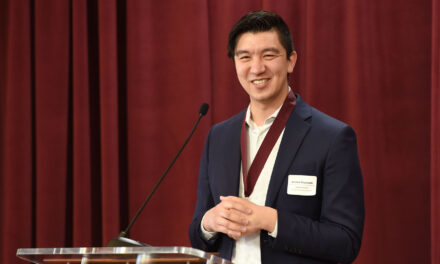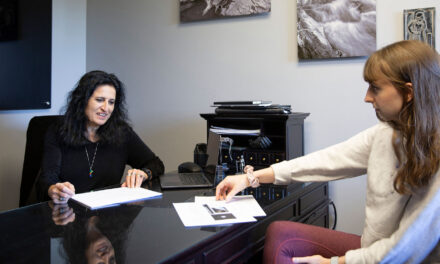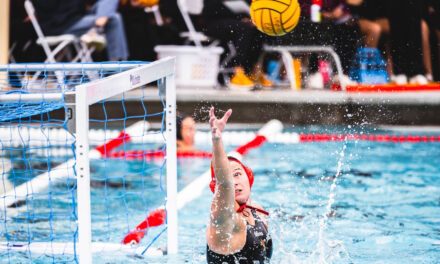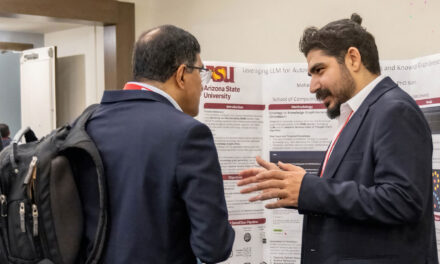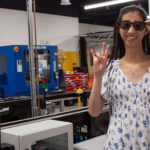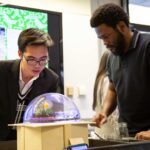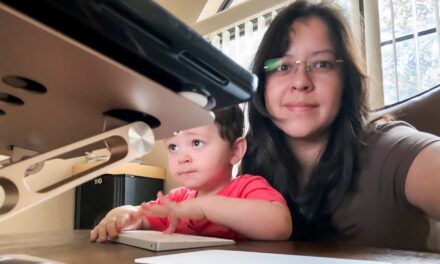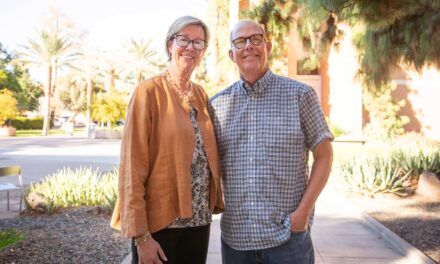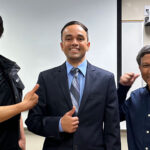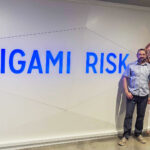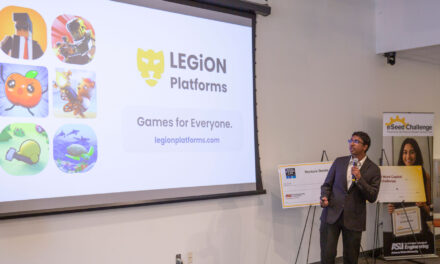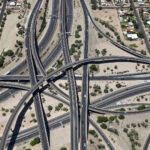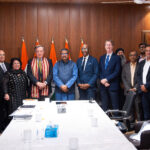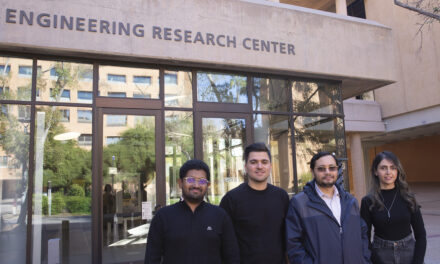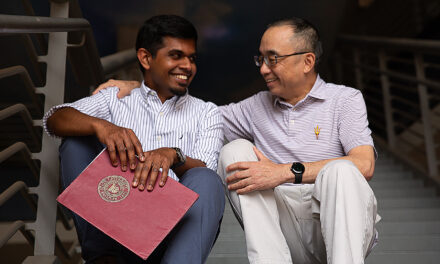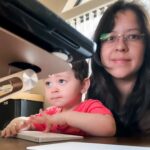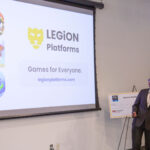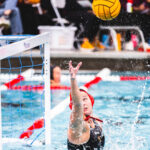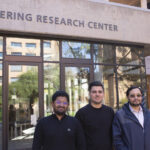
Inspiration springs from engineering education outreach effort
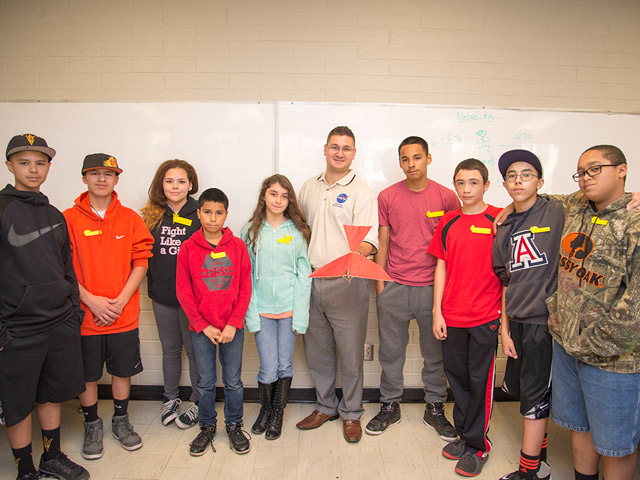
Above: ASU mechanical engineering doctoral student Michael Thompson (center) started a small outreach project in 2012 to introduce youngsters and teens to the basics of engineering design. His series of Saturday instruction sessions have to date attracted more than 160 middle school and high school students — and drawn praise from their teachers. He is pictured with some of the students from the rural town of Superior who were involved in the most recent sessions of the program. Photographer: Hayden Taylor/ASU
Teacher Valerie Garcia-Denogean never imagined she would see young students so excited to get up early on six straight Saturday mornings for an extra day of schooling.
“They were there waiting for the bus every time. Almost no one was late or missed a day,” she recalls.
Those mornings began with a sunrise trip an hour away from their small rural mining community of Superior, Arizona to the sprawling urban Tempe campus of Arizona State University.
Once at their destination, the group of about 20 students gathered with ASU engineering students and professional engineers for four hours of lessons and hands-on activities designed to demystify mathematics, technology and research.
Even with budget cuts in recent years, Superior school district leaders “saw the value of giving our students support for this experience,” says Garcia-Denogean, who teaches both junior high and high school classes and is the district’s career and technical education director.
Along with the district’s curriculum director and transportation supervisor, she volunteered her time to get the students to and from the instruction sessions at ASU.
Eye-opening impact
One group of Superior students completed the six-Saturday series of sessions last fall semester, and another group recently completed the sessions for the spring semester.
The results made the Saturday trips more than worthwhile.
“The impact has been absolutely priceless. Just being in a university environment and meeting college students and business people, and seeing research labs, has been eye-opening for our students,” Garcia-Denogean says.
“I think this will have lasting affects on them. They are learning the terminology of technology and the love of problem-solving, and they are now talking about their future and what they want to do in their lives,” she says.
Success attracting support
All of this is heartening to Michael Thompson, an ASU mechanical engineering doctoral student in ASU’s Ira A. Fulton Schools of Engineering who almost single-handedly launched the outreach program and has since led it over eight semesters.
Offered space and transportation for students in 2012, he spent hundreds of dollars of his own for two years to buy simple teaching materials.
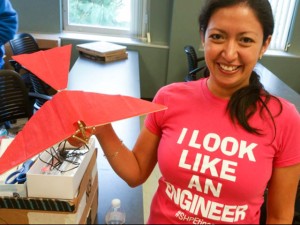
ASU electrical engineering doctoral student Victoria Serrano displays a “Flapping Bird” made of paper and balsa wood. She and other instructors in the ASU Micro Air Vehicle Club engineering outreach program use the toy aircraft to teach young students about the principles of flight and aerodynamics. Photographer: Michael Thompson/ASU
But in 2014 he got a big boost from the National Aeronautics and Space Administration through its NASA Space Grant program, which supports science and engineering education and public outreach. Two annual grants from the program have helped to fund purchase of classroom tools and other technology for instructing students.
The same year, Thompson founded and became president of the Micro Air Vehicle Club engineering student organization at ASU. He recruited club members to help out with what soon became the Micro Air Vehicle Club Outreach Program.
He also got the ASU and Phoenix chapters of the Society of Hispanic Professional Engineers to partner with him.
Educating those most in need
His progress caught the attention of the director of the Fulton Schools of Engineering Career Center, Robin Hammond. She was impressed by Thompson’s enthusiasm and the hard work he put into growing the program.
“Most student outreach projects are one-time things,” Hammond says. “But Michael is engaging students in ongoing learning and building relationships with school districts, and he is focused on helping the underserved communities that are most in need.”
The Career Center awarded Thompson one of its student Professional and Career Development grants, which supplied him with more instructional technology.
In addition, Thompson got an Engineering Projects in Community Service grant from the Institute of Electrical and Electronics Engineers (IEEE) Foundation. It has helped provide students with lunch during the Saturday sessions — something that makes it possible for some families to afford to have their children participate.
Adding high-tech teaching tools
In the beginning, Thompson’s effort was strictly low-tech —informally dubbed the Flapping Bird Outreach Program, since activities consisted almost solely of assembling the mechanical Flapping Bird from kits and using them to teach some simple engineering principles.
Made mostly of balsa wood and lightweight paper, the small kite-like Flapping Birds have been used to introduce students specifically to basic principles of aerodynamics and flight — and to learn such things as how to calculate lift force and drag force, and to plot of flight trajectories.
Small robotic toy cars were later added to the educational materials repertoire.
The Flapping Birds remain popular with the students. But now, with the support Thompson has obtained, the program provides the use of 3D printers and 3D pens for crafting models of various objects, along with technologies and computer programs to access and analyze data, do calculations and measurements, and perform computer-assisted drafting and design.
The high-tech additions enable students to design models of things such as small boats, cell phones, drill bits and drone-like flying machines.
Students see career possibilities
“All of this takes the scary out of math for them. It’s cool to see them realize how they can apply math to solving practical problems and making things,” says ASU mechanical engineering student David Phelps, one of the instructors.
“I am amazed at how quickly they pick up on things. When the sessions are over they’re asking us what they can do to learn to do more of this. That seed of desire has been planted in them,” he says.
Victoria Serrano, an ASU electrical engineering doctoral student and vice president of the ASU Micro Air Vehicle Club, has been one of the key instructors for the past two years.
She says it’s rewarding to watch the students get excited about exploring things they had little or no knowledge of before participating in the program.
“They’re beginning to see that no matter how disadvantaged their families might be, they can think of the possibility of going to college and becoming engineers,” Serrano says.
Plethora of professionals offer guidance
In addition to instruction from ASU engineering students, Thompson has been recruiting more and more professional engineers to contribute to the cause.
Representatives of major companies such as Raytheon Corp., Honeywell, Ford Motors, General Motors, Caterpillar and NorthStar Aerospace have shared their expertise with students.
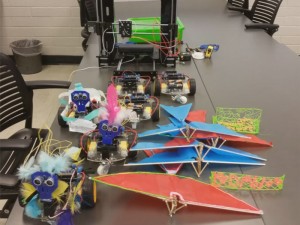
Along with the “Flapping Bird” toys (right), the outreach program uses robotic toy cars (at left, decorated and accessorized) for hands-on activities designed to provide lessons on how math is used to create, test and improve technology. Photographer: Michael Thompson/ASU
“Sometimes we now have almost as many ASU people and professional engineers in the classroom as there are students. So the kids are getting some real individual attention,” says Thompson, who has gotten professional experience working for Ford Motors in Dearborn, Michigan for the past three summers.
He has also earned Ford Motors National Consortium for Graduate Degrees for Minorities in Engineering and Sciences (GEM) fellowship awards in 2013 and 2015 to support his graduate studies.
Personal experiences motivates outreach
To date, more than 160 youngsters have participated in the Thompson’s sessions, and there are plans to draw as many as 80 or so more in total for the fall 2016 and spring 2017 sessions.
New contingents of Superior students are expected to enroll, along with additional students from the even smaller rural Arizona community of Hayden.
The education outreach success will look good on the résumé Thompson is building as he works toward earning his doctoral degree in 2017 and pursuing a career in research. But his motivation is more personal than professional.
Neither Thompson’s parents nor his now three adult siblings graduated from high school, let alone college. The Phoenix native says that situation led him to realize how higher education could open a path to rising out of economic disadvantage into a world of opportunity.
He sees that realization dawning on students in his outreach program.
“The kids come in not really knowing what engineering is, or having any serious interest. By the end, some are talking about what kind of engineers they want be,” he says.
“That is all I want out this, to have that kind of impact on their attitudes about what they can do with their futures,” he adds.
Bringing about cultural change
He’s trying to have that impact closer to home, as well. His 12-year-old sister has been participating in his outreach sessions.
“I’m already pushing on her to go into mechanical engineering,” Thompson says.
His mother began coming along as well. She takes attendance and hand out snacks to students at the sessions.
Thompson “is reaching these girls and boys at the critical ages when they’re beginning to make decisions about the directions they will take,” says Career Center director Hammond, “and with students from these particular communities, what he is doing is helping to bring actual cultural change.”
Through his passion for education and what he’s accomplishing through his schooling in engineering, Thompson is connecting with the young students, Garcia-Denogean says.
“He’s told them about his family experiences and the lack of educational advantages, and they can relate to that,” she says.
“They see what he and the other college students and engineers are doing, and it is nothing less than inspirational.”
Written by Joe Kullman


